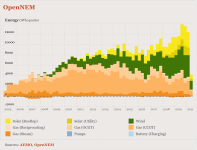... apart from gas.
Gas consumption for electricity generation has boomed massively as coal has declined. This is an unsurprising result of the market penetration of intermittent sources, which need gas to back them up.
Gas did boom when wind and solar first appeared at significant sources, but it appears gas has peaked as increasing amounts of wind and solar are added to the grid:

(I've switched off hydro and coal to just show the relationship between solar/wind and gas)
Of course, if I reduce the timescale and increase the resolution...

...then it's pretty clear that gas won't disappear from the energy mix entirely until something else comes in to replace it in the role of backup supply.
